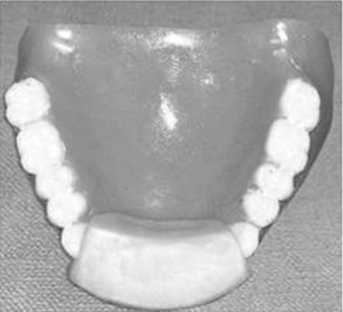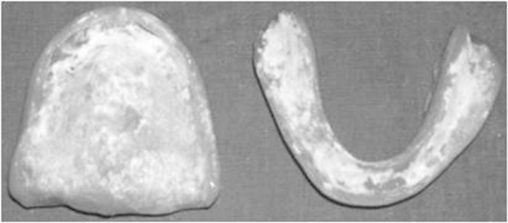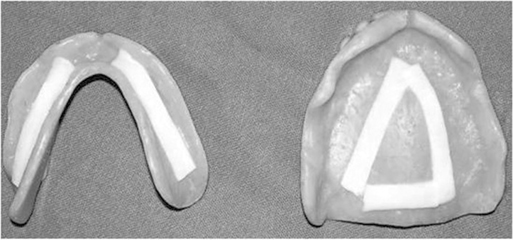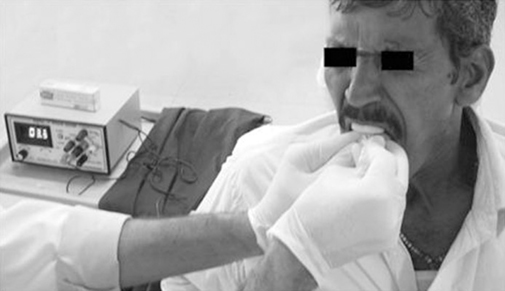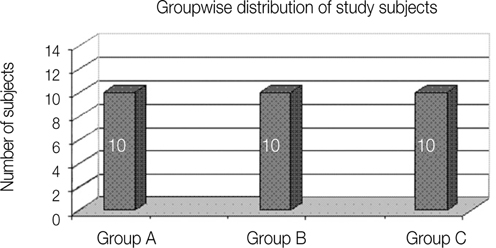J Adv Prosthodont.
2012 May;4(2):97-102.
An investigation into the effect of denture adhesives on incisal bite force of complete denture wearers using pressure transducers: a clinical study
- Affiliations
-
- 1Department of Prosthodontics, Harsarandas Dental College, Ghaziabad, India.
- 2Department of Prosthodontics, SDM College of Dental Sciences, Dharwad, India.
- 3Department of Prosthodontics, College of Dentistry, King Khalid University, Abha, Saudi Arabia. drfarhanshah@yahoo.com
Abstract
- PURPOSE
Study was conducted to determine and assess the effect of different type of denture adhesives on the incisal bite force of complete denture wearers until the dislodgement of upper denture, using pressure transducer.
MATERIALS AND METHODS
30 patients out of 100 were included in the study. Based on the Kapur's method of scoring denture retention and stability, these patients were divided into 3 groups- Group A - Clinically good dentures; Group B - Clinically fair dentures; and Group C - Clinically poor dentures. A custom made occlusal force meter was constructed based on the load cell type of pressure transducers. Different adhesives (powder, paste and adhesive strips) were used in the study. Complete denture wearers were asked to bite on the load cell and the readings of incisal bite force were recorded. The readings of incisal bite force were subjected to statistical analysis using Repeated measures ANOVA followed by post-hoc bonferroni test.
RESULTS
The result suggests that denture adhesives improved the incisal bite force of complete denture wearers significantly The incisal bite force (in kg) in Group A without using adhesives, with powder adhesive, with paste adhesive and with adhesive strips was found to be 2.48 (+/- 0.16), 3.43 (+/- 0.11), 6.01 (+/- 0.11), 3.22 (+/- 0.09) respectively. The incisal bite force (in kg) in Group B without using adhesives, with powder adhesive, with paste adhesive and with adhesive strips was found to be 1.87 (+/- 0.18), 3.35 (+/- 0.14), 5.34 (+/- 0.18), 3.21 (+/- 0.12) respectively. The incisal bite force (in kg) in Group C without using adhesives, with powder adhesive, with paste adhesive and with adhesive strips was found to be 1.00 (+/- 0.17), 3.07 (+/- 0.14), 4.37 (+/- 0.26), 2.99 (+/- 0.14) respectively.
CONCLUSION
Within the limitations of the study, it was concluded that the use of denture adhesive was found to be significantly effective in improving the incisal bite force of complete dentures until the dislodgement of upper denture. Fittydent paste adhesive was found to be more effective than the powder and strips adhesives. The improvement in incisal bite force was found to be higher in Group C in comparison to that of Group A and Group B.
Keyword
MeSH Terms
Figure
Reference
-
1. McKevitt FH. The measured vertical dimension and denture adhesive powders. J Prosthet Dent. 1951. 1:393–401.2. Tarbet WJ, Boone M, Schmidt NF. Effect of a denture adhesive on complete denture dislodgement during mastication. J Prosthet Dent. 1980. 44:374–378.3. Shay K. Denture adhesives. Choosing the right powders and pastes. J Am Dent Assoc. 1991. 122:70–76.4. Adisman IK. The use of denture adhesives as an aid to denture treatment. J Prosthet Dent. 1989. 62:711–715.5. Scher EA, Ritchie GM, Flowers DJ. Antimycotic denture adhesive in treatment of denture stomatitis. J Prosthet Dent. 1978. 40:622–627.6. Psillakis JJ, Wright RF, Grbic JT, Lamster IB. In practice evaluation of a denture adhesive using a gnathometer. J Prosthodont. 2004. 13:244–250.7. Ozcan M, Kulak Y, de Baat C, Arikan A, Ucankale M. The effect of a new denture adhesive on bite force until denture dislodgement. J Prosthodont. 2005. 14:122–126.8. Grasso JE, Rendell J, Gay T. Effect of denture adhesive on the retention and stability of maxillary dentures. J Prosthet Dent. 1994. 72:399–405.9. Kapur KK. A clinical evaluation of denture adhesives. J Prosthet Dent. 1967. 18:550–558.10. Panagiotouni E, Pissiotis A, Kapari D, Kaloyannides A. Retentive ability of various denture adhesive materials: an in vitro study. J Prosthet Dent. 1995. 73:578–585.11. Uysal H, Altay OT, Alparslan N, Bilge A. Comparison of four different denture cushion adhesives-a subjective study. J Oral Rehabil. 1998. 25:209–213.12. Kulak Y, Ozcan M, Arikan A. Subjective assessment by patients of the efficiency of two denture adhesive pastes. J Prosthodont. 2005. 14:248–252.
- Full Text Links
- Actions
-
Cited
- CITED
-
- Close
- Share
- Similar articles
-
- The effect of denture adhesives on the retention of complete denture
- Maxillary complete denture rehabilitation in flabby tissue patient fabricated by no-pressure impression technique with individual tray replicated treatment denture through 3D printing: A case report
- A STUDY ON DIFFERENT AMOUNT OF DENTURE BASE DISPLACEMENT USING SOFT DENTURE RELINING MATERIAL UNDER MASTICATORY FORCE
- Comparative analysis of case series for the prosthetic rehabilitation of edentulous patients using suction denture
- A case report on telescopic denture with a small number of residual teeth in mandible


